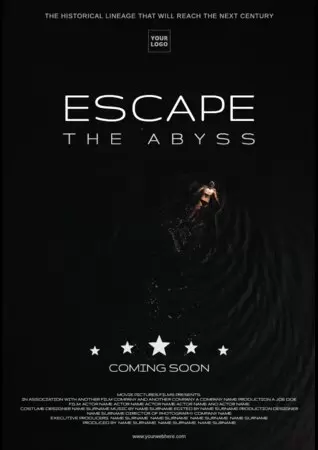Crafting Cinematic Dreams: Unleashing the Power of AI Movie Poster Generators
Crafting Cinematic Dreams: Unleashing the Power of AI Movie Poster Generators
Blog Article

In the ever-evolving landscape of film marketing, the visual appeal of a movie poster plays a crucial role in capturing the audience's attention. With the rise of technology, we find ourselves in an era where artificial intelligence is reshaping creative processes across various industries, including film. Enter the AI movie poster generator, a groundbreaking tool that empowers filmmakers and designers to craft stunning visual representations of their narratives with unprecedented ease.
Sign Up
Imagine having the ability to bring your cinematic vision to life in mere moments, experimenting with colors, styles, and imagery to create the perfect poster. AI movie poster generators harness sophisticated algorithms to analyze design trends and artistic elements, enabling them to generate eye-catching posters that resonate with the essence of the film. As technology continues to advance, these tools not only streamline the creative process but also open up new avenues for artistic expression and innovation in promotional materials.
The Evolution of Movie Poster Design
The history of movie poster design traces back to the early days of cinema, where posters served as essential marketing tools to attract audiences. Initially, these posters were hand-painted artworks that captured the imagination and essence of the films they represented. The use of bold colors, expressive typography, and captivating imagery aimed to draw potential viewers into theaters, transforming the appeal of a film into a visual narrative that resonated with the public.
As the film industry evolved, so did the techniques and styles used in poster design. The mid-20th century saw the emergence of graphic design as a critical element in creating iconic movie posters. Artists like Saul Bass began to implement minimalist designs and innovative compositions, shifting away from overly detailed illustrations to simpler, more powerful graphics. This period marked a significant turning point, where the synergy between art and marketing became increasingly evident.
In recent years, the introduction of technology has further revolutionized movie poster design. With the rise of digital tools, graphic designers have been empowered to experiment with illustrations, photography, and typography like never before. The advent of AI movie poster generators represents the latest frontier, allowing creators to harness artificial intelligence to transform concepts into stunning visuals quickly. This innovation not only streamlines the design process but also opens up new avenues for creativity, making it easier than ever to produce eye-catching and original posters for films of all genres.
How AI Enhances Creativity in Poster Generation
AI movie poster generators are revolutionizing the creative process by providing tools that complement and enhance human imagination. These systems analyze vast datasets of existing movie posters, identifying key visual elements, color schemes, and typography that resonate with audiences. By tapping into these insights, filmmakers and designers can produce posters that not only capture attention but also convey the essence of the film effectively. This interplay between machine learning and artistic design allows creators to experiment with styles and concepts that they might not have considered otherwise.
Furthermore, AI enables rapid prototyping of ideas, which can be crucial in the fast-paced world of film marketing. With just a few clicks, creators can generate multiple versions of a poster, experimenting with different imagery, layouts, and text placements. This flexibility encourages bold creative choices, empowering designers to push the boundaries of traditional poster design. The ability to quickly iterate on concepts helps to streamline the design process, allowing filmmakers to focus on honing the visual narrative that they wish to present.
Moreover, AI algorithms can personalize designs based on target audience analytics. By understanding demographic preferences and trends, these generators can tailor poster designs to resonate with specific viewer groups. This personalized approach not only enhances the creative output but also increases the likelihood that the poster will engage its intended audience. Ultimately, the fusion of AI technology with traditional design practices creates an exciting landscape for filmmakers and marketers, one that unlocks new levels of creativity and visual storytelling.
Future Trends in AI and Movie Promotion
As technology continues to evolve, the future of AI movie poster generators is poised for remarkable advancements that will transform how films are promoted. Enhanced algorithms will allow these generators to create more personalized and engaging content, capturing the essence of a movie's narrative while reflecting the preferences of diverse audiences. By analyzing social media trends and viewer data, AI can design posters that resonate on a personal level, ensuring that promotional materials are not only visually appealing but also strategically tailored to attract specific demographics.
Moreover, the integration of virtual and augmented reality into AI movie poster generation can create immersive marketing experiences. Imagine a movie poster that allows viewers to interact with elements of the film, such as characters or settings, by simply scanning it with their smartphones. This level of engagement could lead to higher anticipation and excitement for an upcoming film, as audiences are drawn into a dynamic world that goes beyond static images. As these technologies converge, the landscape of movie promotion will become increasingly interactive and experiential.
Additionally, collaboration between AI systems and human creatives will redefine the creative process in movie marketing. While AI can generate initial concepts and variations, human designers will analyze the output, add emotional depth, and ensure artistic integrity. This partnership will not only optimize efficiency but also maintain a strong connection with the creative storytelling that defines the film industry. The synergy between AI innovation and human artistry will pave the way for bold, imaginative promotional materials that attract audiences and set new standards in cinematic marketing.
Report this page